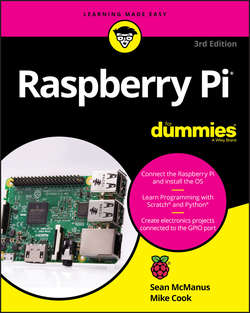Читать книгу Raspberry Pi For Dummies - McManus Sean - Страница 14
На сайте Литреса книга снята с продажи.
Part 1
Setting Up Your Raspberry Pi
Chapter 3
Connecting Your Raspberry Pi
ОглавлениеIN THIS CHAPTER
❯❯ Inserting the SD or MicroSD card
❯❯ Connecting a monitor or TV, keyboard, and mouse
❯❯ Connecting to your router or Wi-Fi
❯❯ Connecting and testing the Raspberry Pi Camera Module
❯❯ Using Raspi-config to set up your Raspberry Pi
The thought of being faced with a bare circuit board might strike you as rather daunting, but it’s actually quite easy to connect your Raspberry Pi and get it up and running. You might need to change some of its configuration (see Appendix A), but many people find that their Raspberry Pi works well the moment they connect it all together.
Before we start, make sure you have the Raspberry Pi facing the right way around, at least as far as these directions are concerned. The top of your Raspberry Pi is the side that has the most components and sockets sticking out of it, and is shown in Figures 3-1, 3-2 and 3-3. The back is relatively flat. Arrange your Raspberry Pi so that the spiky GPIO pins are in the top left, or in the case of a Pi Zero or Zero W without pins, so that the 40 holes are in the top left.
FIGURE 3-1: The original Model B Raspberry Pi. The Model A is the same, except that it has no Ethernet.
FIGURE 3-2: The Raspberry Pi 3 Model B. The same layout applies to the Raspberry Pi 2 Model B, the Model B+, and the Model A+ (with changes on the right).
FIGURE 3-3: The Raspberry Pi Zero W. The same layout applies to the Raspberry Pi Zero, except that there is no camera connector.
Figure 3-1 shows the ports and sockets you will need to use to connect up an original Model B Raspberry Pi. The Model A is the same as Figure 3-1 except that it has no Ethernet connection in the bottom right.
Figure 3-2 shows the connection points on the Raspberry Pi 3 Model B. This layout also applies to the Raspberry Pi 2 Model B, and the Model B+. At first glance, the Model A+ looks quite different because it's a smaller board, but it's the same layout except for the right edge, where there is no Ethernet socket and just the one USB port.
Figure 3-3 shows the Raspberry Pi Zero W. The Raspberry Pi Zero looks the same, except that it is missing the camera socket on the right.
Chapter 1 lists everything you might need in order to use your Raspberry Pi, including the various cables.
